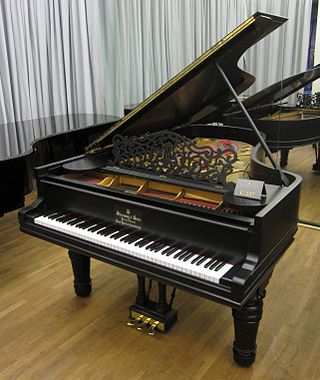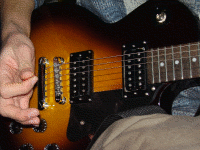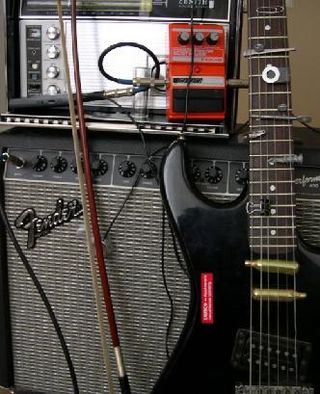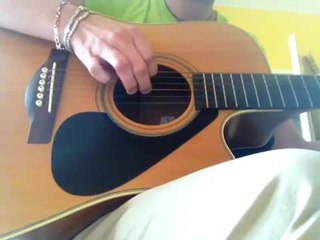This article needs additional citations for verification .(July 2023) |


Damping is a technique in music for altering the sound of a musical instrument by reducing oscillations or vibrations. Damping methods are used for a number of instruments.
This article needs additional citations for verification .(July 2023) |


Damping is a technique in music for altering the sound of a musical instrument by reducing oscillations or vibrations. Damping methods are used for a number of instruments.
Damping is often necessary on string instruments such as the bass or violin where sympathetic resonance can excite other strings creating undesired noise. This phenomenon can be remedied by keeping fingers such as the thumb on the strings where the vibration is unwanted. [2]
On guitar, damping (also referred to as choking) is a technique where, shortly after playing the strings, the sound is reduced by pressing the right hand palm against the strings, right hand damping (including palm muting), or relaxing the left hand fingers' pressure on the strings, left hand damping (or left-hand muting). Scratching is where the strings are played while damped, i.e., the strings are damped before playing. The term presumably refers to the clunky sound produced. In funk music this is often done over a sixteenth note pattern with occasional sixteenths undamped.
Floating is the technique where a chord is sustained past a sixteenth note rather than that note being scratched, the term referring to the manner in which the right hand "floats" over the strings rather than continuing to scratch.
Skanking is when a note is isolated by left hand damping of the two strings adjacent to the fully fretted string, producing the desired note (the adjacent strings are scratched). The technique is especially popular among ska, rocksteady and reggae guitarists, who use it with virtually every riddim they play on.
When a piano key is pressed, the damper for that note is raised and a hammer strikes the string. Unless the sustain pedal is depressed, releasing the key allows the damper to return to place, damping the note.
Percussion instruments, such as timpani or cymbals, often resonate for a long time. To control the length of the notes, percussionists will often have to either place their hands on the instrument or use a pedal mechanism as in the case of tubular bells and pedal glockenspiels.
Mallet dampening on the vibraphone is an important technique that facilitates legato phrasing on the instrument. It is accomplished by striking a note on one of the bars of the instrument while the pedal is depressed and then using the head of the same or another mallet to stop the vibrations of the bar without raising the pedal.
There are many benefits of being proficient in this technique as a vibraphonist. As it allows a player to hold out one chord and add or subtract any individual pitch desired, a vibist can transition between chords much more smoothly than a pianist who cannot stop a string from vibrating without reaching inside the instrument when the pedal is down. Most modern vibraphonists are highly skilled in this technique.
On cymbals, choking is an important technique that can add punctuation or heighten musical tension.
While the keys on modern pianos control both the hammers and dampers, this is not possible with the hand-held hammers used to play some other members of the box zither family. Historical players such as Joseph Moskowitz sometimes used their coat sleeves as dampers, but pedal-operated dampers were one of the main distinguishing features of the concert cimbalom developed by Jószef Schunda in 1874 and are now often added to larger or more expensive American hammered dulcimers, Eastern European dulcimers, and Greek sandouris. They are rarely if ever found on the Romanian ţambal mic, the Iranian santur, or the Indian santoor.

The hammered dulcimer is a percussion-stringed instrument which consists of strings typically stretched over a trapezoidal resonant sound board. The hammered dulcimer is set before the musician, who in more traditional styles may sit cross-legged on the floor, or in a more modern style may stand or sit at a wooden support with legs. The player holds a small spoon-shaped mallet hammer in each hand to strike the strings. The Graeco-Roman word dulcimer derives from the Latin dulcis (sweet) and the Greek melos (song). The dulcimer, in which the strings are beaten with small hammers, originated from the psaltery, in which the strings are plucked.

The piano is a keyboard instrument that produces sound when the keys are pressed. Most modern pianos have a row of 88 black and white keys: 52 white keys for the notes of the C major scale and 36 shorter black keys raised above the white keys and set further back, for sharps and flats. This means that the piano can play 88 different pitches, spanning a range of a bit over seven octaves. The black keys are for the "accidentals", which are needed to play in all twelve keys.

A percussion instrument is a musical instrument that is sounded by being struck or scraped by a beater including attached or enclosed beaters or rattles struck, scraped or rubbed by hand or struck against another similar instrument. Excluding zoomusicological instruments and the human voice, the percussion family is believed to include the oldest musical instruments. In spite of being a very common term to designate instruments, and to relate them to their players, the percussionists, percussion is not a systematic classificatory category of instruments, as described by the scientific field of organology. It is shown below that percussion instruments may belong to the organological classes of idiophone, membranophone, aerophone and chordophone.

In musical instrument classification, string instruments or chordophones, are musical instruments that produce sound from vibrating strings when a performer plays or sounds the strings in some manner.

The vibraphone is a percussion instrument in the metallophone family. It consists of tuned metal bars and is typically played by using mallets to strike the bars. A person who plays the vibraphone is called a vibraphonist,vibraharpist, or vibist.

A mute is a device attached to a musical instrument which changes the instrument's tone quality (timbre) or lowers its volume. Mutes are commonly used on string and brass instruments, especially the trumpet and trombone, and are occasionally used on woodwinds. Their effect is mostly intended for artistic use, but they can also allow players to practice discreetly. Muting can also be done by hand, as in the case of palm muting a guitar or grasping a triangle to dampen its sound.

The palm mute is a technique for guitar and bass guitar known for its muted sound. It is performed by placing the side of the picking hand across the guitar's strings, very close to the bridge, while picking. The name is a misnomer as the muting is not performed using the player's palm.

In music, extended technique is unconventional, unorthodox, or non-traditional methods of singing or of playing musical instruments employed to obtain unusual sounds or timbres.

Gamelan gong kebyar is a style or genre of Balinese gamelan music of Indonesia. Kebyar means "to flare up or burst open", and refers to the explosive changes in tempo and dynamics characteristic of the style.

The trapezoidal yangqin is a Chinese hammered dulcimer, likely derived from the Iranian santur or the European dulcimer. It used to be written with the characters 洋琴, but over time the first character changed to 揚, which means "acclaimed". It is also spelled yang ch'in. Hammered dulcimers of various types are now very popular not only in China, but also Eastern Europe, the Middle East, India, Iran, and Pakistan. The instruments are also sometimes known by the names "santoor" and "cymbalom". This instrument had an influence on the Thai classical instrument, known as Khim (ขิม).

In music, strumming is a way of playing a stringed instrument such as a guitar, ukulele, or mandolin. A strum or stroke is a sweeping action where a finger or plectrum brushes over several strings to generate sound. On most stringed instruments, strums are typically executed by a musician's designated strum hand, while the remaining hand often supports the strum hand by altering the tones and pitches of any given strum.
Keyboard expression is the ability of a keyboard musical instrument to change tone or other qualities of the sound in response to velocity, pressure or other variations in how the performer depresses the keys of the musical keyboard. Expression types include:

A sustain pedal or sustaining pedal is the most commonly used pedal in a modern piano. It is typically the rightmost of two or three pedals. When pressed, the sustain pedal "sustains" all the damped strings on the piano by moving all the dampers away from the strings and allowing them to vibrate freely. All notes played will continue to sound until the vibration naturally ceases, or until the pedal is released.
Left-hand muting is a performance technique for stringed instruments, where string vibration is damped by the fingering hand.
A damper is a device that deadens, restrains, or depresses. It may refer to:

The soft pedal or una corda pedal, is one pedal on a piano, generally placed leftmost among the pedals. On a grand piano this pedal shifts the whole action slightly to the right, so that the hammers, which normally strike all three of the strings for a note, strike only two of them. This softens the note and also modifies its tone quality. Tone quality is also affected by forcing the remaining two strings being struck to make contact with a part of the hammer felt which is not often hit ; this results in a duller sound, as opposed to the bright sound which is usually produced.

Piano pedals are foot-operated levers at the base of a piano that change the instrument's sound in various ways. Modern pianos usually have three pedals, from left to right, the soft pedal, the sostenuto pedal, and the sustaining pedal. Some pianos omit the sostenuto pedal, or have a middle pedal with a different purpose such as a muting function also known as silent piano.

Guitar picking is a group of hand and finger techniques a guitarist uses to set guitar strings in motion to produce audible notes. These techniques involve plucking, strumming, brushing, etc. Picking can be done with:
Piano extended techniques are those in which unorthodox or unconventional techniques are used to create the sound.

There are several overlapping schemes for the classification of percussion instruments.